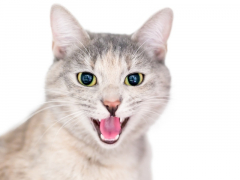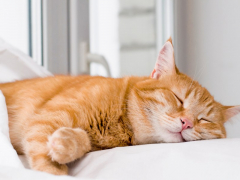
Chronic kidney disease (CKD) is unfortunately a very common illness seen in middle aged to older cats. With few treatment options other than dietary changes, it’s common for cat parents to ask if there are any supplements that may help. In this article, you’ll learn what supplement types are beneficial as well as specific products.
What Do the Kidneys Do?

A cat’s kidneys are vital to health making kidney disease a significant concern that some supplements may be able to help with. Benny Marty / Shutterstock.com
To know what supplements may be helpful for CKD and why, it’s first important to understand what the kidneys do and what kidney disease does to the body.
Saying the kidneys make pee is certainly true, but this is a big oversimplification of a complex organ.
Remove Waste
Urine is inherently a waste product. So one of the kidney’s roles in producing urine is to make sure that certain waste products leave the body. The blood urea nitrogen (BUN) and creatinine values your vet discusses with you from your cat’s lab work are two of those waste products. They result from protein and muscle breakdown. If the kidneys are not excreting them normally, they build up in the bloodstream.
Bringing Balance: Water, Minerals/Electrolytes, Vitamins
The kidneys also have the job of making sure the body retains certain nutrients it needs while getting rid of the rest. The kidneys are crucial for the body retaining water to stay hydrated. Nutrients and elements like B vitamins, Phosphorus, Potassium, and Chloride are carefully kept in balance by the complicated tubule system within the kidneys. Some is retained and some excreted, depending on what the body needs.
Red Blood Cell Production
The kidneys produce a hormone called erythropoietin (EPO), which tells the bone marrow to make more red blood cells.
Effects of Chronic Kidney Disease on the Body

More frequent trips and longer periods spent in the litter box are common behaviors in cats with chronic kidney disease (CKD). Kirsten McCarthy / Cats.com
When the kidneys are not functioning correctly, waste removal, water and nutrient balance, and red blood cell production can all be affected.
Removal of waste products like BUN and creatinine gets harder and harder for the kidneys to do as function deteriorates, leading to progressively higher values for these on bloodwork.
Balance for water, electrolytes, and vitamins is greatly thrown off. Some things we notice very early in the disease. The first sign most cat parents notice is that their cat needs to drink and pee a lot more. This comes from the kidneys’ reduced ability to retain water.
Water soluble vitamins, namely B vitamins, are easily lost through the urine when a cat urinates excessively. B vitamins are very important parts of the digestion of nutrients as well as other processes in the body.
Electrolytes are needed by the body for many functions, even those that are as small as the basic functions of cells. Potassium is a common electrolyte lost through progressive renal disease. Phosphorus is another one that can be classified as either a waste product or an electrolyte. Phosphorus is important for the body’s nutritional needs, but when the kidneys cannot excrete it properly, excesses can compound signs of illness.
Red blood cell production is usually not affected significantly until later stages of kidney disease, but anemia and low levels of iron can both result from the kidneys’ reduced ability to signal the bone marrow to make more red blood cells.
Where Can Supplements Help?
Cats can adjust and cope with the effects of CKD in earlier stages since it tends to initially progress very slowly over time. It’s not uncommon for a cat in the earliest stages of CKD (IRIS stages I or II) to show few outward changes other than increased drinking and urination behavior.
But as CKD progresses into the higher end of IRIS stage II and certainly into stages III and IV, more significant effects develop. This is where supplements may help the most.
Specific Supplements for Cats with Kidney Disease
For our purposes here I’m considering supplements as non-prescription items. One primary approach to treating chronic kidney disease is through dietary therapy. Due to the need for specific levels of protein and phosphorus restriction, while keeping the calcium to phosphorus ratio appropriate, prescription diets are the best approach for most cats.
Subcutaneous (under the skin) fluids are also important in the later stages of CKD but must be prescribed and require some instruction to do so successfully. We won’t discuss them in detail in this article.
Hypertension is a common complication in cats with kidney disease, but not something supplements can address and requires prescription medication. We will not touch on hypertension in this article, but see our article on hypertension in cats for more information.
Toxin/Azotemia Support
Azotemia simply refers to the elevations in BUN and creatinine on blood work that occurs with kidney disease. Uremia is a similar term referring to these same components in a medical sense being present in the bloodstream. When these reach higher levels around 4-5 (the upper end of IRIS stage III CKD) appetite changes become more noticeable.
Azodyl

Azodyl, made by Vetoquinol, is a probiotic supplement. The three bacterial strains included can thrive in uremic environments and can help to manage uremic toxins. Improvements in lab work values of BUN and creatinine may be seen in as little as 4 weeks. I have seen this myself in patients.
Two downsides to Azodyl are that it must be refrigerated and that it is fairly expensive for a supplement.
Vitamins and Minerals
The primary vitamin and mineral deficiencies that occur are potassium and B vitamins since they are readily lost through urine.
Potassium gluconate supplements are commonly used as a way of supplementing potassium levels.
While many veterinarians can offer B complex vitamin supplementation for injection either at their hospitals or for owners to do at home, an easier place to start can be with the same supplement for low potassium. Some brands, like Renal K + below, include not just potassium gluconate, but also B vitamins (such as niacin, cyanocobalamin, biotin, folic acid, thiamine, etc.).
Others, like RenaPlus and RenaKare gel, only contain potassium gluconate.
Renal K +

This supplement made by Vetoquinol contains potassium gluconate as well as a host of B vitamins. It comes in both a powder form that can be mixed with food, or a gel form.
In cats that are suspicious if the powder is mixed with their food, the gel may be a more successful route. If they won’t lick it up on their own, apply some of the gel to your furry friend’s foot and their innate need to groom themselves will do the rest.
Phosphorus Binding
While an important mineral for the body, phosphorus can be very damaging to the kidneys. There are theories that high phosphorus content in cat foods may be one of the underlying causes of chronic kidney disease in cats. When the kidneys can no longer function well, their ability to process even normal levels of phosphorus is diminished. We can see phosphorus elevate in the bloodstream just like BUN and creatinine. With higher levels in the bloodstream, we can see signs of nausea and poor appetite.
One strategy to approach phosphorus is to feed a diet that is low in phosphorus. The problem here is that while a minimum nutritional need for phosphorus has been firmly established and is generally followed by pet food manufacturers, a maximum level currently is not established in the NRC nutritional guidelines for cats. As a result, there is no maximum for cats set by AAFCO either.
This makes prescription diets for kidney disease the most reliable source of a phosphorus restricted diet. Transitioning to a prescription kidney diet is an initial goal for most veterinarians when counciling cat owners on therapy options for CKD. But since we know cats are finicky, a diet change isn’t always possible. Diets restricted in phosphorus may also not be sufficient alone.
This is where phosphorus binders come in. Through one or more mechanisms, they bind up phosphorus in the diet so that it will be passed through the fecal route instead of making the kidneys try to excrete it.
Aluminum Hydroxide
Aluminum hydroxide is one substance that can bind phosphorus. It is an easy to find item in the antacid section of any pharmacy department since it is most commonly used by people for heartburn. Traditional over the counter brands include Amphojel and Alternagel.
Giving for extended periods or at higher doses may lead to aluminum toxicity over time, though this is considered a rare side effect.
Other antacids also include magnesium hydroxide and simethicone. Simethicone has little to no beneficial effects for cats that we know of, though no toxicity concerns. Magnesium supplementation should be done with care in cats with CKD. While it has not been shown to be deleterious to cats with earlier stages of CKD, in later stages where kidney failure causes high magnesium levels, supplementing additional magnesium would not be appropriate.
The magnesium may also induce a laxative effect. For some cats with CKD, this may actually be beneficial but may not be for others.
But the biggest drawback to aluminum hydroxide for cats usually relates to the mint flavor of most products and the high volume of liquid needed. Some veterinarians may look for ways to get it compounded into a more acceptable form.
Calcium Carbonate
While easily available as over the counter TUMS, calcium carbonate is not often used as a phosphorus binding agent. While it will bind phosphorus, it will also increase calcium levels in the body, causing an imbalance and risk for hypercalcemia, as well as bladder stones. Bloodwork must be routinely monitored to check calcium and phosphorus levels. Given the added expense of this and the risk, vets usually advise other alternatives.
Epakitin

Epakitin is a product made by Vetoquinol which uses chitosan to bind phosphorus. Chitosan comes largely from shellfish and is very similar in structure to glucosamine.
Epakitin does work very well as a phosphorus binding agent but has a couple of drawbacks. Epakitin comes only as a powder, which may be problematic for some cats as it needs to be mixed with soft food. It also tends to be expensive for a supplement.
Naraquin

Naraquin is a newer phosphorus binding agent made by Nutramax. Naraquin utilizes three methods of phosphorus binding. Chitosan is included, similar to Epakitin. Calcium acetate is a form of calcium with a higher binding affinity for phosphorus and a better safety threshold compared to calcium carbonate.
Ferric citrate is the most unique ingredient in Naraquin. It binds phosphorus, but may also provide a source of dietary iron, something that CKD kitties with anemia may be deficient in. While Naraquin comes in a sprinkle capsule form, the yeast flavoring of Nutramax products is highly palatable for cats in my own experience.
It’s important to note that while damaging to the kidneys at certain levels, phosphorus is a nutrient every living animal’s body needs. The ratio of calcium to phosphorus is also very important. If phosphorus is too low, high levels of calcium can lead to secondary illnesses like hypercalcemia and bladder stones.
Antioxidants
Antioxidants are substances that help protect cells from the effects of damaging free radicals. Free radicals are unstable atoms that can be found commonly in states of inflammation, other diseases, and with aging.
There are many types of antioxidants, including vitamin C, vitamin E and omega-3 fatty acids. These are found in many kidney-friendly pet foods and supplements (Naraquin for example has omega-3 included) but can also be supplemented separately.
For some of the best reviewed and tested nutritional supplements for cats, see our 8 Best Cat Vitamins and Supplements. Of particular note include:
- Tomlyn High-Calorie Nutritional Gel: contains lots of B vitamins, iron, and antioxidants
- Zesty Paws Wild Alaskan Salmon Oil: contains omega-3’s, especially DHA and EPA
- Animal Nutritional Products UroMAXX: contains vitamin C
When Should I Start a Supplement for My Cat with Kidney Disease?
The need to start a supplement may depend on the stage of CKD your cat has, what deficiencies are known or suspected, and what clinical signs or symptoms your cat is showing.
Any level of azotemia (BUN and creatinine elevation) should prompt an initial attempt at dietary therapy with a prescription diet restricted in phosphorus. Protein restriction is also a part of dietary therapy but depends on the stage of CKD. Earlier stages do not require the same degree of protein restriction that later stages do.
As a product that targets reduction in azotemia, Azodyl could be considered at any time in a cat with BUN and creatinine elevations.
Potassium likely only requires supplementation if lab work shows levels that are low normal or below. However, supplementing B vitamins can be important at any stage as they help with digestion and appetite and are important for multiple other processes in the body. There is no risk to over supplementing B vitamins as the body will always excrete what it doesn’t need.
Phosphorus binding agents are most often only added when the phosphorus level on bloodwork starts getting close to 6 mg/dl or higher. However, I would argue that a phosphorus binder should be added any time dietary restriction of phosphorus through a prescription or other confirmed low-phosphorus diet is not possible.
Antioxidants can be considered at any time, especially if combined with B vitamins.
-
Hohenhaus, A. (2017, June 21). Are there supplements to use with cats that have been diagnosed with chronic kidney disease? . Schwarzman Animal Medical Center
-
Llera, R., & Downing, R. (n.d.). Nutrition for Cats with Kidney Disease. VCA Animal Hospitals.
-
International Renal Interest Society (IRIS). (2023). IRIS Staging of CKD. IRIS.
-
Schauf, S., Coltherd, J. C., Atwal, J., Gilham, M., Carvell‐Miller, L. J., Renfrew, H., Elliott, J., Elliott, D., Bijsmans, E. S., Biourge, V. C., Watson, P., & Bakke, A. M. (2021). Clinical progression of cats with early‐stage chronic kidney disease fed diets with varying protein and phosphorus contents and calcium to phosphorus ratios. Journal of Veterinary Internal Medicine, 35(6), 2797–2811. https://doi.org/10.1111/jvim.16263
-
Cornell University College of Veterinary Medicine. (n.d.-a). Chronic Kidney Disease. Cornell Feline Health Center.
-
Tang, P., Van Den Broek, D. H. N., Jepson, R. E., Geddes, R. F., Chang, Y., Lötter, N., Moniot, D., Biourge, V., & Elliott, J. (2024). Dietary magnesium supplementation in cats with chronic kidney disease: A prospective double‐blind randomized controlled trial. Journal of Veterinary Internal Medicine, 38(4), 2180–2195. https://doi.org/10.1111/jvim.17134
-
Aranaz, I., Alcántara, A. R., Civera, M. C., Arias, C., Elorza, B., Caballero, A. H., & Acosta, N. (2021). Chitosan: An overview of its properties and applications. Polymers, 13(19), 3256. https://doi.org/10.3390/polym13193256







